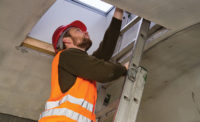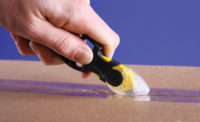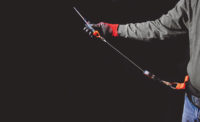From warehouses and distribution facilities to the factory floor, thousands of workers depend on safety knives to perform important jobs while providing an extra layer of injury-preventing protection.
As workplace safety becomes increasingly important, safety knives have crossed over from their origins in shipping and receiving departments to industries such as construction, manufacturing, food preparation and processing, healthcare and more. As the safety knife becomes more popular, however, the number of options from which safety managers can select has dramatically increased.
So how to choose?
First, it’s important to understand the difference between three types of knives.
Semi-automatic safety knife
The first type of safety knife to enter the market, the semi-automatic safety knife is the granddaddy of them all. This knife is easily adopted in many types of facilities, and the concept behind them is simple: When a user engages the thumb slide and moves the blade across the material being cut, the force of the cut will keep the blade extended so the user can remove their thumb from the slide. Once the blade loses contact with the cutting surface, the blade retracts.
Semi-automatic knives are helpful because safety managers don’t need to remind employees to always close the blade, which helps prevent one of the most common accidents: injury due to reaching for a knife and touching an open blade.
Fully automatic safety knife
Every facility has an employee who doesn’t like using a blade that retracts, so he tapes the blade open to override the safety feature. This is where a fully automatic safety knife comes into play. Once a user starts cutting with this knife, it doesn’t matter whether a thumb is on or off the blade slide; the blade operates independently of the blade lever and will self-retract once the blade loses contact with the cutting surface, so there is no way to tape the blade open and “cheat” the safety feature.
While it may seem like fully automatic makes more sense safety-wise, both fully and semi-automatic knives are equally safe, and both have their individual uses.
In settings where employees need to make longer or faster cuts, or when cutting shrink wrap or any material where the knife easily loses contact with the cutting surface, a semi-automatic blade may be better suited to the job.
Concealed blade knife
Another type of safety knife is the concealed blade knife, also known as a “zero-liability” knife. In this variety, the blade is always open, but concealed within a cutting channel, so the user is always protected from injury because there is zero exposure to the blade at all times, whether cutting or not. This allows users to make quick, safe cuts.
Depending on the model, this knife style can cut thinner materials like plastic wrap and polybag up to two-wall corrugated. A concealed knife is designed to allow a user to start cutting stretch wrap at the top of a pallet and cut all the way down.
A spinoff of the concealed blade safety knife is the rolled materials cutter. This type of knife is designed to cut materials that normally come in rolls, like carpet, roofing felt, landscaping mesh, leather and vinyl. Designed with an enclosed rotary blade, the solid base prevents damage to the surface under the material being cut, and forces the user to cut away from himself.
Some concealed-blade knives are disposable, creating a one-two punch for safety managers: The blade in the cutting channel protects employees while cutting, and when the blade gets dull, instead of an employee needing to change it, they simply throw the knife away and get a new one. Some facilities have adopted a safety protocol in which employees absolutely never touch or change a blade, so this type of knife is ideal for those environments.
Ask these important questions
- “What will employees be cutting?” Because there are so many different types of safety knives, material matters.
- “What is the thickness of the material?” How thick a material is dictates how long a knife’s blade exposure should be.
- “What knife do my employees currently use?” If the answer is “none,” then an entry-level safety knife may be preferred. If the answer is “entry level,” that brings you to the last question.
- “Why is entry level not working, and what new safety specs do we need?” Employees familiar with entry-level safety knives may be able to override the safety features, which means the company may require an accelerated version of a safety knife to further reduce accidents.
Other considerations
The most important thing a safety manager needs to consider is the rate of adoption. Employees will be naturally resistant to change, so a safety manager must be confident that it will be easy to swap out the mechanism employees currently use for a new safety product.
Quality remains critical; a safety knife can come with every bell and whistle, but if it doesn’t cut, you’ve lost your employees on the first use.
Training is integral in helping employees understand how a safety product works and how easy it is to use. Many manufacturers provide free knife safety training for companies switching to new products.
A safer future
No two industries think about knife safety the same way; it all comes back to a facility’s specific goals; an employee’s specific job functions; what kind of material is being cut; and where the material is being cut. Yet while knife safety remains a priority in every industry, safety knives will continue to evolve to ensure they aren’t just doing the cutting – they’re keeping users safe as well.



